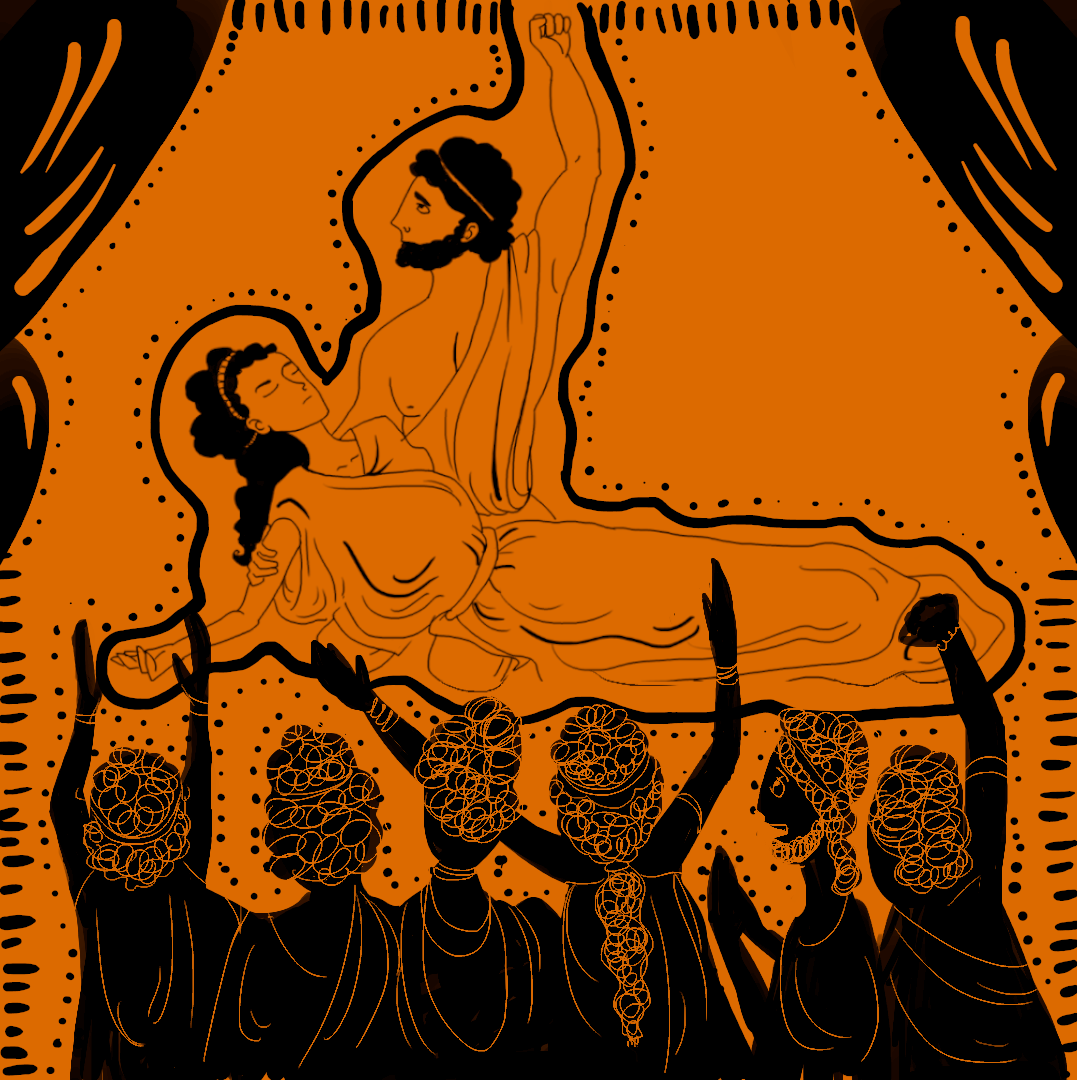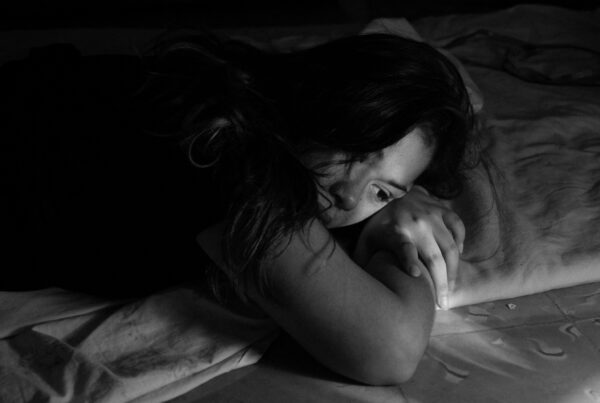
Do you find yourself seeking angst-filled poetry or sad songs? Do you ever find yourself chomping down spicy food while your mouth is burning and your nose is runny? Have you and your friends ever excitedly planned horror movie marathons knowing that you have a week of nightmares ahead of you? We humans often gain pleasure from actions that aren’t usually associated with pleasure. Why do we enjoy negative feelings or painful experiences, and even actively seek them?
Do you find yourself seeking angst-filled poetry or sad songs? Do you ever find yourself chomping down spicy food while your mouth is burning and your nose is runny? Have you and your friends ever excitedly planned horror movie marathons knowing that you have a week of nightmares ahead of you? We humans often gain pleasure from actions that aren’t usually associated with pleasure. Why do we enjoy negative feelings or painful experiences, and even actively seek them?

Illustration by Carolien de Bruin

Illustration by Carolien de Bruin
The paradox of tragedy is an age-old philosophical puzzle, prominently discussed by the likes of Aristotle and David Hume. From Shakespearean tragedies to our present-day horror movies, we humans actively seek certain unpleasant states and negative emotions and find some sort of pleasure in them. Through the course of the eighteenth century, several philosophers have been riddled with this paradox, and have posited their theories, although none of them stood their ground against all possible situations (Tobón, 2012). However, exploring the theories and explanations offered by philosophers previously is still an interesting approach.
One of the early theories was that we may take pleasure when witnessing pain because we are not the ones suffering. Thus, this implies that our pleasure is rooted in ‘the secret comparison which we make between ourselves and the person who suffers’ (Addison, Steele & Chalmers, 1853 as cited in Tobón, 2012). This explanation was propagated by philosophers like Lucretius, Thomas Hobbes, and Joseph Addison. In Addison’s explanation though, he believes that we find this pleasure in fictional depictions of misery from the past, as opposed to real life and present-day events, because of a certain distance that is created from the pain.
Jean-Baptiste Du Bos, like Addison, did not believe we would experience pleasure upon seeing tragedy in reality. For Du Bos, interestingly enough, boredom was one of the most miserable states one could be in. According to him, representations of tragedy gave rise to strong artificial negative emotions, which gave some sort of pleasure derived from being relieved of boredom (Livingston, 2013). Since these negative emotions are stirred up because of representations, not reality, Du Bos calls them ‘artificial’, and considers them to be weaker than the emotions that arise from actual events. All in all, it appears that Du Bos views representations of tragedy as a form of entertainment, but one without the consequences accompanied by actual real-life tragedies.
Further, from Edmund Burke, we get some sort of a ‘solution’ for this puzzle, a way to utilise this feeling of pleasure. Burke’s explanation is that we are naturally made in such a way that we are attracted to the pain and suffering of others. Thus, the pleasure we gain from this is further mobilised such that we come to the rescue of those who are afflicted. His argument, however, involves some dodgy reasoning, as he believes that it is God who has made us the way we are (i.e. as beings who are drawn to the pain of others).
In his paper, Tobón (2012) analyses these theories and ultimately concludes that perhaps a unitary theory explaining this paradox is not possible. To date, in fact, solutions are being offered to explain this age-old paradox. A couple of the more contemporary theories we will be discussing ahead are the meta-response theory by Susan Feagin (1983) and the acknowledgement theory by Evers and Deng (2015).
“we get pleasure from tragedy in art because the piece of art acknowledges these aspects of life”
A philosopher from the late twentieth century, Susan Feagin, puts forward the theory that rests on the premise that our pleasure is a meta-response to tragic art. She first delineates the difference between direct and meta responses; direct responses being a response to the work of art itself (for instance, how an art piece makes us feel) while the meta response is a response to the direct response (i.e. how we feel about feeling or responding that way). Essentially, Feagin believes we take pleasure from the fact that we respond a certain way to tragedies and the fact that we have these emotions. She links this to the concept of morality, and how we might be satisfied that our responses of pity and sympathy might be an indication of moral response on our part. In addition to this, Feagin also highlights how we gain pleasure knowing that we aren’t alone in how we feel, and there is a certain universality to our experiences. The old philosopher Jean-Jacques Rousseau also has a similar chain of thought, that we take pleasure at our sympathy and compassion, but he considers this to be artificial since it is a response to fictitious representations and does not require us to mobilise that feeling of compassion. It gives off the impression that the pleasure from our meta-response is selfish in some sense.
Evers and Deng (2015) don’t seem to think that we spend so much time reflecting on the art itself and our responses to them, as Feagin’s theory would presume. For one, we wouldn’t be writing this article if we weren’t engaging in such reflection! Furthermore, Feagin also talks of how we may feel we’re not alone in our experiences. However, one could also feel pain without having any actual experience just as well, for instance, living through a war. Evers and Deng contend that artwork could be a way for others to experience situations they’ve never found themselves in. Responding to the paradox of tragedy itself though, Evers and Deng believe we get pleasure from tragedy in art because the piece of art acknowledges these aspects of life. This acknowledgement does not happen in real-life events, and hence, tragedy in real life doesn’t give us pleasure. This is what they term the ‘acknowledgement theory’.
“Pain or psychological distress can count as effort and their presence can, in the end, justify that something was worth doing.”
In these past theories and explanations, philosophers have had different opinions on whether we gain pleasure solely from art or representations of tragedy and pain, or from real-life situations as well. However, it certainly seems like there are plenty of situations when people actively seek negative feelings that are evoked from actual stimuli. Think about eating very spicy crisps, going on a crazy rollercoaster ride, or watching documentaries about true, gruesome crimes. Why would anyone like that? There is at least one important reason why, at first sight, enjoying any form of pain should be irrational. Pain should work as a signal to deter us from danger. Because we are motivated to avoid pain, we make decisions that would keep us safe. It feels as though we are going against our nature if we find or seek a sense of pleasure in physical and psychological pain. Psychologists have proposed a series of explanations as well.
In his talk at the University of New South Wales, ‘The Pleasures of Suffering’, developmental psychologist Paul Bloom presents several theories to account for people’s tendency to enjoy suffering. One point he makes is that pleasure is relative, that it depends on contrasts. This means that a positive feeling can be enhanced by a negative one occurring right before it. Challenging times make people appreciate the good things in their life more. Moreover, Bloom argues that humans have a tendency to notice and embrace the negative because it can serve as a training ground for difficult situations in the future. For instance, the fact that people often think of worst-case scenarios or like to hear about real tragedies might be an advantage for their survival because it prepares them to deal with such situations. If there is a way to safely experience the unpleasant, it makes sense to take the opportunity and learn how to best react – it might be very useful when bad things happen unexpectedly.
Another reason for seeking suffering is the sense of meaning found in difficult tasks. This is what psychologists call the paradox of effort. The more effort someone puts into a task, for example working hard on a project, the more meaning they will attach to it and the more of an achievement it will be viewed as. The paradox of effort has been observed in humans as well as in animals and has been explained by several theories including learned industriousness (effort is rewarded, therefore, it becomes desirable in itself), effort justification as a result of cognitive dissonance (forming a positive attitude towards an action to justify the losses incurred for engaging in it) and the contrast effect mentioned above (Inzlicht, Shenhav, & Olivola, 2018). Consequently, to be sure something will be very rewarding for you, make it a hard thing to achieve. Pain or psychological distress can count as effort and their presence can, in the end, justify that something was worth doing. This could explain why some people love to run exhausting marathons or face extreme conditions during mountain climbing.
“People can get energy and motivation to stand up for a cause through negative feelings.”
Morality, Bloom argues, is yet another domain where suffering might not be experienced negatively in the common sense of the word. This happens when sadness, anger, and pain are endured for the purpose of third-party punishment. People can get energy and motivation to stand up for a cause through negative feelings. The negative feeling is preferred because it makes the person who experiences it feels like they are a better person (because anger indicates somebody has been wrong and a reaction will follow), but also because it increases the satisfaction associated with revenge.
It is always interesting to understand why we humans engage in strange behaviour – actively engaging and calling for feelings of pain and suffering, be it through art or from real life, definitely sounds like one of these. But it’s not as strange as it sounds. It actually appears to be a very human thing, something we all experience in different ways.<<
References
– Evers, D., & Deng, N. (2015). Acknowledgement and the paradox of tragedy. Philosophical Studies, 173(2), 337–350.
– Feagin, S. (1983). The Pleasures of Tragedy. American Philosophical Quarterly, 20(1), 95-104.
– Tobón, D.J. (2012). On the Paradox of Tragedy: Notes for the Balance of Its Theoretical Heritage. Proceedings of the European Society of Aesthetics, 4, 560-575.
– Inzlicht, M., Shenhav, A., & Olivola, C. Y. (2018). The effort paradox: Effort is both costly and valued. Trends in cognitive sciences, 22(4), 337-349.
– Livingston, P. (2013). Du Bos’ Paradox. The British Journal of Aesthetics, 53(2), 393-406.
– Paul Bloom (Talk at UNSW) – The Pleasures of Suffering: https://www.youtube.com/watch?v=_cbVUxiRY8A
The paradox of tragedy is an age-old philosophical puzzle, prominently discussed by the likes of Aristotle and David Hume. From Shakespearean tragedies to our present-day horror movies, we humans actively seek certain unpleasant states and negative emotions and find some sort of pleasure in them. Through the course of the eighteenth century, several philosophers have been riddled with this paradox, and have posited their theories, although none of them stood their ground against all possible situations (Tobón, 2012). However, exploring the theories and explanations offered by philosophers previously is still an interesting approach.
One of the early theories was that we may take pleasure when witnessing pain because we are not the ones suffering. Thus, this implies that our pleasure is rooted in ‘the secret comparison which we make between ourselves and the person who suffers’ (Addison, Steele & Chalmers, 1853 as cited in Tobón, 2012). This explanation was propagated by philosophers like Lucretius, Thomas Hobbes, and Joseph Addison. In Addison’s explanation though, he believes that we find this pleasure in fictional depictions of misery from the past, as opposed to real life and present-day events, because of a certain distance that is created from the pain.
Jean-Baptiste Du Bos, like Addison, did not believe we would experience pleasure upon seeing tragedy in reality. For Du Bos, interestingly enough, boredom was one of the most miserable states one could be in. According to him, representations of tragedy gave rise to strong artificial negative emotions, which gave some sort of pleasure derived from being relieved of boredom (Livingston, 2013). Since these negative emotions are stirred up because of representations, not reality, Du Bos calls them ‘artificial’, and considers them to be weaker than the emotions that arise from actual events. All in all, it appears that Du Bos views representations of tragedy as a form of entertainment, but one without the consequences accompanied by actual real-life tragedies.
Further, from Edmund Burke, we get some sort of a ‘solution’ for this puzzle, a way to utilise this feeling of pleasure. Burke’s explanation is that we are naturally made in such a way that we are attracted to the pain and suffering of others. Thus, the pleasure we gain from this is further mobilised such that we come to the rescue of those who are afflicted. His argument, however, involves some dodgy reasoning, as he believes that it is God who has made us the way we are (i.e. as beings who are drawn to the pain of others).
In his paper, Tobón (2012) analyses these theories and ultimately concludes that perhaps a unitary theory explaining this paradox is not possible. To date, in fact, solutions are being offered to explain this age-old paradox. A couple of the more contemporary theories we will be discussing ahead are the meta-response theory by Susan Feagin (1983) and the acknowledgement theory by Evers and Deng (2015).
“we get pleasure from tragedy in art because the piece of art acknowledges these aspects of life”
A philosopher from the late twentieth century, Susan Feagin, puts forward the theory that rests on the premise that our pleasure is a meta-response to tragic art. She first delineates the difference between direct and meta responses; direct responses being a response to the work of art itself (for instance, how an art piece makes us feel) while the meta response is a response to the direct response (i.e. how we feel about feeling or responding that way). Essentially, Feagin believes we take pleasure from the fact that we respond a certain way to tragedies and the fact that we have these emotions. She links this to the concept of morality, and how we might be satisfied that our responses of pity and sympathy might be an indication of moral response on our part. In addition to this, Feagin also highlights how we gain pleasure knowing that we aren’t alone in how we feel, and there is a certain universality to our experiences. The old philosopher Jean-Jacques Rousseau also has a similar chain of thought, that we take pleasure at our sympathy and compassion, but he considers this to be artificial since it is a response to fictitious representations and does not require us to mobilise that feeling of compassion. It gives off the impression that the pleasure from our meta-response is selfish in some sense.
Evers and Deng (2015) don’t seem to think that we spend so much time reflecting on the art itself and our responses to them, as Feagin’s theory would presume. For one, we wouldn’t be writing this article if we weren’t engaging in such reflection! Furthermore, Feagin also talks of how we may feel we’re not alone in our experiences. However, one could also feel pain without having any actual experience just as well, for instance, living through a war. Evers and Deng contend that artwork could be a way for others to experience situations they’ve never found themselves in. Responding to the paradox of tragedy itself though, Evers and Deng believe we get pleasure from tragedy in art because the piece of art acknowledges these aspects of life. This acknowledgement does not happen in real-life events, and hence, tragedy in real life doesn’t give us pleasure. This is what they term the ‘acknowledgement theory’.
“Pain or psychological distress can count as effort and their presence can, in the end, justify that something was worth doing.”
In these past theories and explanations, philosophers have had different opinions on whether we gain pleasure solely from art or representations of tragedy and pain, or from real-life situations as well. However, it certainly seems like there are plenty of situations when people actively seek negative feelings that are evoked from actual stimuli. Think about eating very spicy crisps, going on a crazy rollercoaster ride, or watching documentaries about true, gruesome crimes. Why would anyone like that? There is at least one important reason why, at first sight, enjoying any form of pain should be irrational. Pain should work as a signal to deter us from danger. Because we are motivated to avoid pain, we make decisions that would keep us safe. It feels as though we are going against our nature if we find or seek a sense of pleasure in physical and psychological pain. Psychologists have proposed a series of explanations as well.
In his talk at the University of New South Wales, ‘The Pleasures of Suffering’, developmental psychologist Paul Bloom presents several theories to account for people’s tendency to enjoy suffering. One point he makes is that pleasure is relative, that it depends on contrasts. This means that a positive feeling can be enhanced by a negative one occurring right before it. Challenging times make people appreciate the good things in their life more. Moreover, Bloom argues that humans have a tendency to notice and embrace the negative because it can serve as a training ground for difficult situations in the future. For instance, the fact that people often think of worst-case scenarios or like to hear about real tragedies might be an advantage for their survival because it prepares them to deal with such situations. If there is a way to safely experience the unpleasant, it makes sense to take the opportunity and learn how to best react – it might be very useful when bad things happen unexpectedly.
Another reason for seeking suffering is the sense of meaning found in difficult tasks. This is what psychologists call the paradox of effort. The more effort someone puts into a task, for example working hard on a project, the more meaning they will attach to it and the more of an achievement it will be viewed as. The paradox of effort has been observed in humans as well as in animals and has been explained by several theories including learned industriousness (effort is rewarded, therefore, it becomes desirable in itself), effort justification as a result of cognitive dissonance (forming a positive attitude towards an action to justify the losses incurred for engaging in it) and the contrast effect mentioned above (Inzlicht, Shenhav, & Olivola, 2018). Consequently, to be sure something will be very rewarding for you, make it a hard thing to achieve. Pain or psychological distress can count as effort and their presence can, in the end, justify that something was worth doing. This could explain why some people love to run exhausting marathons or face extreme conditions during mountain climbing.
“People can get energy and motivation to stand up for a cause through negative feelings.”
Morality, Bloom argues, is yet another domain where suffering might not be experienced negatively in the common sense of the word. This happens when sadness, anger, and pain are endured for the purpose of third-party punishment. People can get energy and motivation to stand up for a cause through negative feelings. The negative feeling is preferred because it makes the person who experiences it feels like they are a better person (because anger indicates somebody has been wrong and a reaction will follow), but also because it increases the satisfaction associated with revenge.
It is always interesting to understand why we humans engage in strange behaviour – actively engaging and calling for feelings of pain and suffering, be it through art or from real life, definitely sounds like one of these. But it’s not as strange as it sounds. It actually appears to be a very human thing, something we all experience in different ways.<<



